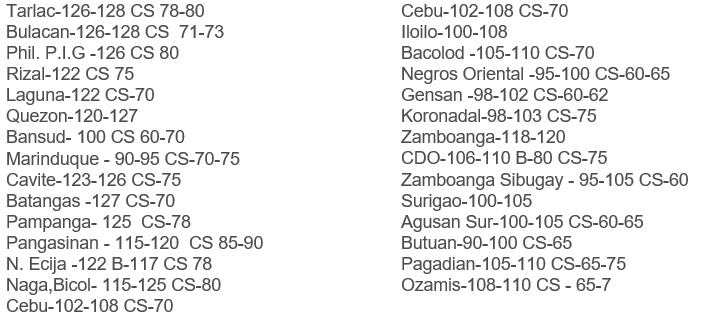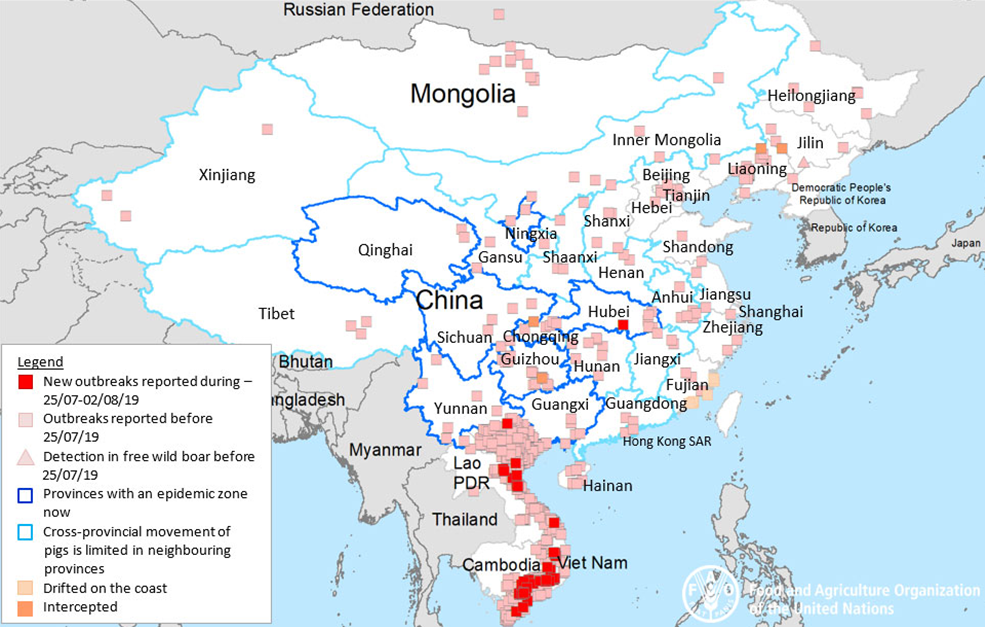



Genesus Global Market Report: South-East Asia July 2019
India is about to ramp up it’s pig production!
India
During a recent business trip to India it became obvious that there is a change about to happen with a number of pig production projects being planned and although we have seen this before, this time it feels real.
In India the pig farming sector is highly disorganised and some of the salient features are following:
In India, 70 percent of the pig population is reared under traditional small holder, low-input demand driven production system, except for a limited number of semi-commercial pig farms in Kerala, Punjab and Goa. The typical production system consists of a simple pig sty and feeding comprises locally available grains, vegetables and agricultural by-products along with kitchen waste.
Pork consumption being popular among select populations, improved pig husbandry programmes and pig-based integrated fish farming have significantly contributed in the poverty alleviation strategies of the government. Distribution of pig population across the country is not uniform, for instance, large population of pigs are recorded in the eastern (2.8 million) and north-eastern (4.5 million) states; highest population is in Asom (2 million), followed by Uttar Pradesh (1.35 million), West Bengal (0.82 million), Jharkhand (0.73 million) and Nagaland (0.70 million).
Most of the pig population is again in the tribal belts of the country where the people are non-vegetarian.
Breeding Level
Over 20 percent of the pigs kept in India are crossed with exotic breeds, but with a large amount of inbreeding because of non-systematic breeding and selection. In nutshell, the pig rearing is still a disorganised venture that requires science and technology driven support to make it a vibrant enterprise.
The total pigs in the country have decreased by 7.54 percent over the previous census and the total pigs in the country are 10.29 million numbers in 2012. The total pigs contribute around 2.01 percent of the total livestock population. Out of the total population, number of males are 4.96 million (3.68 million indigenous and 1.28 million exotic) and 5.33 million are females (4.16 million indigenous and 1.17 million exotic).
Pork production
Pork production in India is limited, representing only 9 percent of the country’s animal protein sources. Production is concentrated mainly in the north eastern corner of the country and consists primarily of backyard and informal sector producers. According to 19th Livestock Census of India (2012), the total swine population, while small, has grown consistently over the past 50 years. However, in the most recent decade, the population has declined to approximately 10 million head from a high of 14 million in 2003, as indicated by the 17th Livestock Census of India.
Present pork meat production
The meat production in the country as per 2014-15 data was 6.6 million tons with a per capita availability of 4.94 kg. Of this, pig contributed 9 percent. The total meat production in 2014/15 by pig was 464.11 thousand tons.
Processed Pork
The Indian market for processed pork products is small, and the majority of this market is supplied through imports. Although there are some local companies which manufacture processed products such as sausages and bacon, quantities are limited and the industry is small. According to MoFPI, there are 3600 slaughter houses in India, although the majority of these facilities do not export. There is a small number of abattoirs in India which meet international standards. However, these facilities do not process pork meat.
The vast majority takes place in the informal sector in the form of locally raised fresh pork meat. This meat is not widely distributed in the organised retail sector. Given cultural perceptions and consumer perceptions about pork meat, consumption of fresh local meat is limited to north eastern India where pork consumption is more prevalent.
The second segment of the pork market deals with high-value imported products. These products include cured meats such as sausages, ham, bacon and canned meat products, as well as small quantities of frozen meat. They are typically found in most leading Indian hotels catering to international business travellers and tourists. Additionally, there is demand for imported pork products amongst well-travelled Indian consumers and foreigners residing in India. Processed products such as sliced meats, hams, bacon and sausage can be found in specialty shops and high-end restaurants.
In the next ten years, it is predicted that the total consumption of meat in India will double from its present numbers. As per capita income of individuals rises, they tend to spend on improving their lifestyle and food consumption habits. Pork consumption is negligible in India, with the exception of the north-east while it is a major item elsewhere. In the European Union, 42.6 kg pork is consumed per person every year, while in the US, 29.7 kgs are consumed. Pork is a staple for Chinese, and so over 35 kg are consumed per person per year.
India’s States and regions are diverse in terms of economic factors affecting food demand, including population, income, and urbanisation.
North-East India
The eight states in North East India (Assam, Arunachal Pradesh, Manipur, Meghalaya, Mizoram, Nagaland, Sikkim and Tripura) are ethnically and culturally akin to South East Asia and are amongst the poorest in India with a much higher proportion of the population below the poverty line (35 percent) than the national average (26 percent). For the majority tribal population, livestock keeping – especially pig keeping - is integral to their way of life in the NE Region. There is a growing demand for pork due to increasing per capita income, urbanization and changes in lifestyle and food habits. Much of this demand is met from imports from other states in India and from Myanmar. North East India has much higher pork consumption that the rest of the country. Of these states, Nagaland has the highest per capita consumption. The tribal population in particular appears to consume more pork on average than other groups. Traders in both Assam and Nagaland reported that the demand for pork was increasing along with prices.
South India
Goa, Karnataka, Andhra Pradesh, Tamilnadu, Kerala, Bangalore - states are meat-eaters and small Christian sectors also consume pork. Pork is a popular meat in Goa and the eastern states of India. It is eaten by the Portuguese Christians in Goa.
Kolkata (West Bengal) - Community of immigrants and descendants; Chinese population of 7000. So the demand of pork meat is high.
Current situation in the Indian Pig Sector, In comparison to other livestock species, pig rearing has higher potential to contribute to more economic gain for small, marginal farmers or rural poor belonging to the lowest socioeconomic strata due to its following advantages:
- Better feed conversion efficiency of pigs i.e. they attain more unit weight gain per kg of feed consumed as compared to other meat producing animals except broilers.
- Higher fecundity in pigs – Sows produce 6 - 12 piglets in each farrowing. 3) Pigs reach sexual maturity at an early age. A sow can be bred as early as 8 - 9 months of age and can farrow twice in a year under optimal management conditions.
- Pigs have shorter generation interval as compared to other classes of livestock
- Offers quick returns since the market weight of 60-90 kg can be achieved in a period of 7-10 months.
- One of the few livestock animals where nearly all parts of the animal can be consumed by the farm family and/or sold.
- Converts damaged feeds which are either not edible or not very palatable to human beings into valuable nutritious meat.
- Apart from providing meat, it is also a source of bristles and manure
- Can survive and grow on wide variety of feed stuff viz. grains, vegetables, fruits, fodder, sugarcane, kitchen waste. 10) Piggery employment opportunities to seasonally employed rural farmers and supplement income to improve their living standards
- Require little initial investment on building and gear.
- Pigs can be raised for their entire lifetime in enclosure as they do not contribute to loss of grazing lands.
- Pig products range from primary commodities such as pork, to processed food products such as sausages and smoked hams to cooked salted ears, eaten as snack foods.
- Demand for pig's fat in poultry feed, soap, paints and other chemical industries.
- The small scale pig sector has seemingly greater potential to reduce poverty.
Modern day Genetics such as Genesus offer Indian pig farms a huge opportunity to increase production and reduce the cost of production, the gap between the Indian pig sector today and Genesus genetics is vast.
Is India ready for the best pigs in the World !!
Nigeria
The first shipment of Genesus breeding stock arrived in Nigeria early in July 2019, the pigs were exported from the Genesus Nucleus and Multiplication herds in the UK, the pigs have settled in well into this new farm.
Thailand
African Swine Fever is getting closer to Thailand in the second quarter of the year as it is spreading into Laos, after hitting Cambodia early in April. Both countries share the border with Thailand.
ASF prevention measures which have been stringent in the country are being beefed up further. The worst-case scenario is being assessed, and this is leading pig farmers from across Thailand to take additional steps towards the ASF prevention.
Starting from the cooperative of pig farmers in Ratchaburi province, which is Thailand’s largest pig production hub, it is pooling money from its members at USD 1/sow and USD 0.15/commercial pig to set up a fund. It is expected to get USD 500,000 from the campaign. This amount will be used to buy pigs from backyard farms and poor biosecurity farms in the province.
To support this initiative, the Thai Swine Raisers Association, which is the national grouping of pig farmers in Thailand, is requesting pig farmers across the country to pool the money at the similar rate as the cooperative.
The association is expected to get USD 3.3 million from the donation. This amount of money will be used to buy pigs from backyard farms and poor biosecurity farms along the provinces bordering Laos and Cambodia. This is aiming to set up a buffer zone to prevent the ASF virus to get into the pig production areas that are located farther away from the border.
Some large pig producers in Thailand have started buying pigs from backyard farms located in 1.5-3km around their premises. These pigs will be slaughtered and kept in the cold storage.
Biosecurity is also being beefed up at abattoirs across the country. The focus is being placed up on substandard abattoirs, which is under control of the local administration. Routine disinfection is being implemented. In some areas such as Ratchaburi province, it is compulsory for all the trucks to be disinfected before loading pigs from the farm and after unloading pigs at the abattoir.
ASF testing facility and equipment are being set up to speed up the testing procedure and ensure the reliability of the test result.
Pig price stable. Pig price in Thailand fell slightly in the second quarter as some farmers were panicking and selling out their pigs in mass for fear that the ASF would be broken out in the country. Anyhow, the price is now stable at around USD2.2-2.5/kg live.
The inventory of pigs in Thailand is expected to decline further as some pig farmers were slowly cutting down the number of their sows and market pigs to the level that they can comfortably manage biosecurity at their facility.
Philippines
Pork Producers Weekly Prices as of July 30, 2019 (NET Price)

Vietnam
The liveweight price of the pig now is 40,000 – 44,000 vnd/kg in the North; 30,000 – 40,000 vnd/kg in the center and 28,000 – 35,000 vnd/kg in the South. Average will be around 37,000 vnd/kg. This price has increased slightly.
According to Agriculture & Rural Development of Ha Noi, 35.5 percent of the backyard pig farm have been destroyed due to ASF. But local sources believe this to be as high as 50 percent or even more.
Hung Nhon will invest in Dac Lac province with 2,400 sows GGP/GP.
Vietnam have been culled 3.7 million of pigs already
According to the lunar calendar, this month is the month for to eat vegetarian food and normally the price of the pig will go down. But this time it is opposite and pig prices are on the increase, this means the number of the pigs is less than the demand. This has been caused by the ASF Deaths and culling plus the reduction in the selling weight caused by panic selling encase they get ASF.











